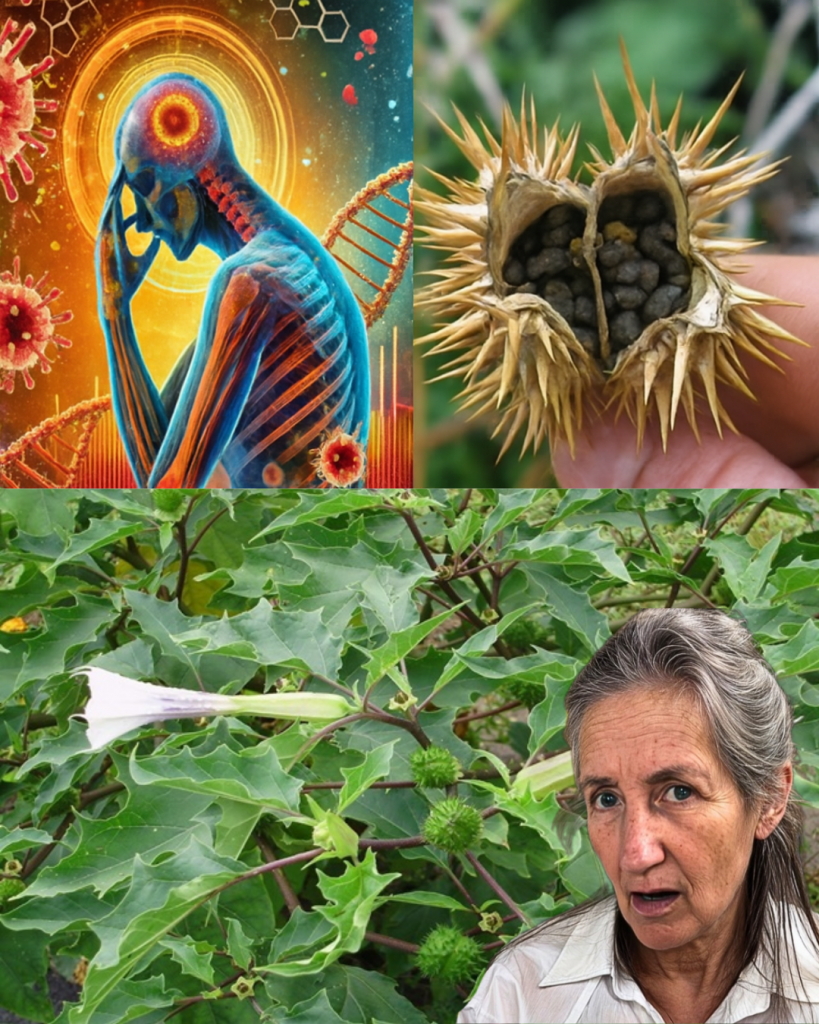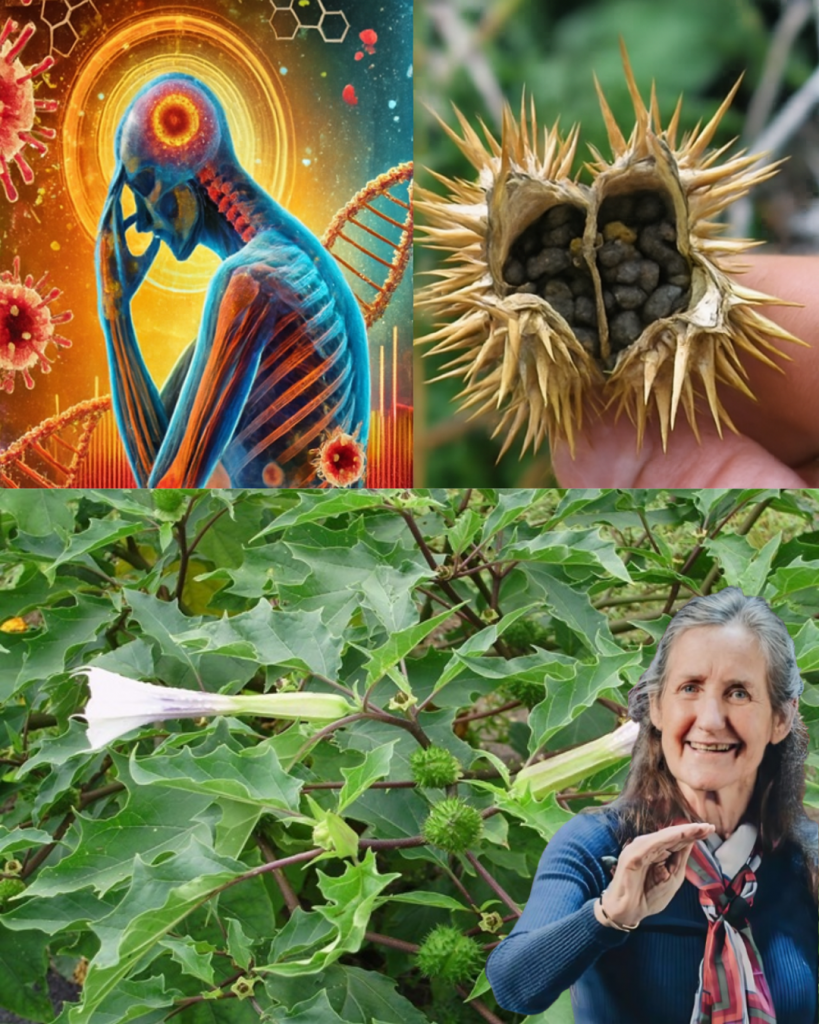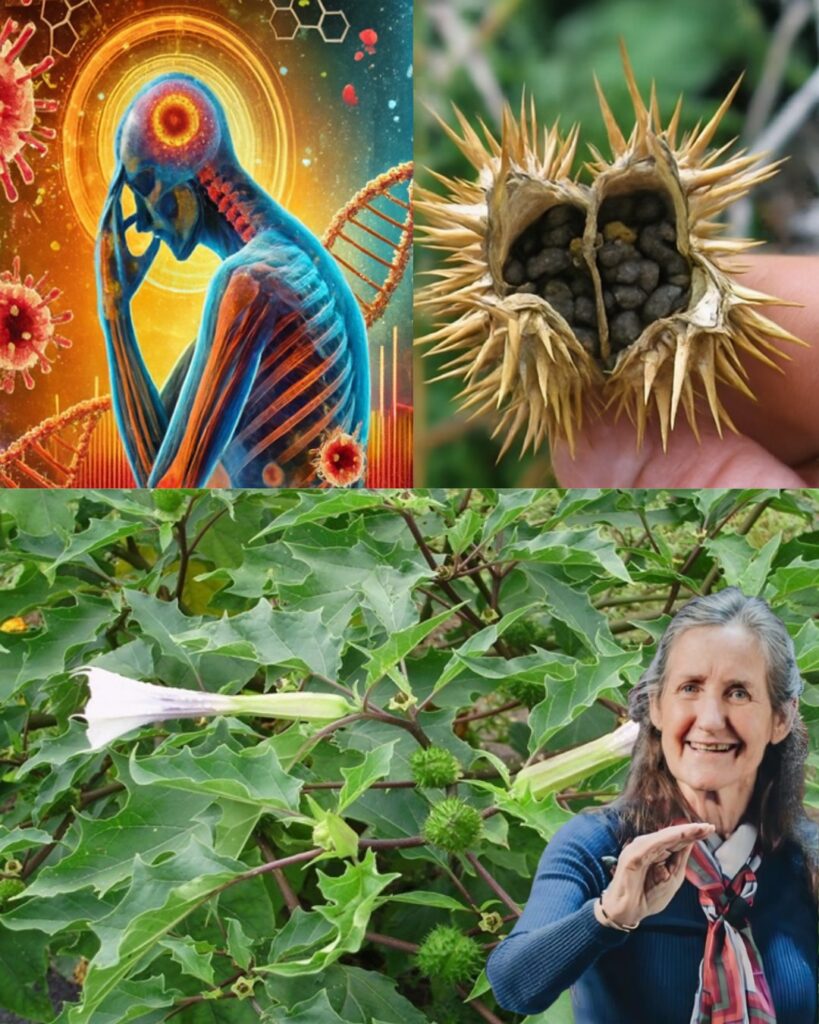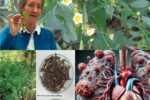The Devil’s Trumpet: Unraveling the Deadly Allure of Datura Stramonium 🌸
It grows wild along roadsides, blooms under the moonlight, and captivates with its ethereal beauty. But beneath its stunning exterior, Datura stramonium—known as thorn apple, jimsonweed, or devil’s trumpet—hides a sinister secret. This plant, with its intoxicating fragrance and striking flowers, is one of nature’s most dangerous creations. Its potent toxins can plunge the curious into a world of hallucinations, delirium, or even death. Intrigued? You should be. Dive into the enigmatic world of Datura stramonium to discover why this plant is both revered and feared, and learn how to protect yourself from its deadly charm.

A Plant of Beauty and Betrayal 🌿
At first glance, Datura stramonium is a vision of elegance. Its trumpet-shaped flowers, glowing white or soft purple, unfurl at dusk, releasing a sweet, heavy scent that lures pollinators and passersby alike. Its spiky seed pods and jagged leaves add a touch of wild allure, making it a favorite for adventurous gardeners. But this beauty is a master of deception. Every part of the plant—leaves, flowers, seeds, and roots—is laced with toxic alkaloids that can wreak havoc on the human body. One moment of curiosity could lead to a life-altering encounter. Why does such a stunning plant carry such a dark side? Let’s explore its secrets and uncover the truths that make Datura stramonium a plant of fascination and fear.
A Global Wanderer with a Deadly Legacy 🌍
Datura stramonium, a member of the nightshade family (Solanaceae), originated in the Americas but has conquered the globe, thriving in disturbed soils like roadsides, pastures, and urban wastelands. This hardy annual grows up to 2 meters tall, with broad, lobed leaves and distinctive seed pods that burst open to scatter tiny black seeds. Its adaptability and resilience make it a common sight, but its widespread presence only heightens its danger. From rural fields to city gardens, Datura stramonium lurks where you least expect it, ready to ensnare the unaware. Its global reach is a testament to its survival skills—and a warning of its potential to harm.
The Toxic Trio: Atropine, Scopolamine, and Hyoscyamine ⚠️
What makes Datura stramonium so deadly? The answer lies in its chemical arsenal: atropine, scopolamine, and hyoscyamine. These tropane alkaloids disrupt the nervous system by blocking acetylcholine, a critical neurotransmitter. The result? A cascade of symptoms that can range from uncomfortable to catastrophic. Even a small dose can trigger dry mouth, blurred vision, rapid heartbeat, and confusion. Larger amounts unleash terrifying hallucinations, delirium, seizures, and, in extreme cases, coma or death. The plant’s toxicity is unpredictable, varying with growing conditions, making it impossible to gauge a “safe” dose. This lethal unpredictability is why Datura stramonium is a plant to respect from a distance.
A History of Mysticism and Medicine 📜
Despite its dangers, Datura stramonium has a storied past. For centuries, cultures worldwide have harnessed its potent properties for spiritual, medicinal, and ritualistic purposes. In traditional medicine, it was used to treat asthma, muscle spasms, and pain, with carefully controlled doses of its alkaloids offering therapeutic benefits. In spiritual practices, shamans and healers employed Datura to induce visions, believing it connected them to the divine. But these uses came with a cost. Miscalculations often led to poisoning, and its hallucinogenic effects were as likely to terrify as to enlighten. Today, modern medicine extracts its alkaloids for pharmaceuticals, but its recreational use remains a dangerous gamble. Datura’s dual nature—healer and destroyer—continues to captivate and caution.
The Hidden Dangers in Your Backyard 🚨
Datura stramonium’s beauty makes it a tempting addition to gardens, but its presence is a ticking time bomb, especially in homes with children or pets. Accidental ingestion is a leading cause of poisoning, as curious kids or animals may be drawn to its spiky pods or fragrant flowers. Even handling the plant without gloves can cause skin irritation or mild toxicity through absorption. In 2019, a large outbreak in Uganda saw over 200 people poisoned after consuming humanitarian relief food contaminated with Datura seeds, highlighting its potential for widespread harm. Urban foragers and nature enthusiasts are also at risk, mistaking it for edible plants due to its resemblance to harmless species. The stakes are high, and awareness is your first line of defense.
Symptoms of Datura Poisoning: A Terrifying Ordeal 😵
Ingesting or mishandling Datura stramonium can unleash a nightmare of symptoms, often within an hour. The initial signs are subtle but escalate rapidly:
- Dry Mouth and Thirst: The alkaloids halt saliva production, leaving the mouth parched.
- Blurred Vision and Dilated Pupils: Eyes become sensitive to light, and vision blurs.
- Rapid Heartbeat and Fever: The heart races, and body temperature spikes.
- Confusion and Hallucinations: Reality unravels, replaced by vivid, often terrifying visions.
- Seizures and Delirium: In severe cases, the body convulses, and the mind spirals into chaos.
- Coma or Death: High doses can shut down vital systems, leading to fatal outcomes.
These symptoms can persist for 24 to 48 hours, leaving survivors shaken and disoriented. Prompt medical intervention is critical to prevent long-term damage or death.
Who’s at Risk? The Vulnerable and the Curious 🧒🐶
Datura stramonium poses a unique threat to specific groups. Children, drawn to its unusual seed pods, may ingest them out of curiosity. Pets, especially dogs, may chew on its leaves or flowers, unaware of the danger. Teenagers and thrill-seekers sometimes consume Datura for its hallucinogenic effects, underestimating its risks. Unlike controlled psychedelics, Datura’s hallucinations are unpredictable and often distressing, increasing the likelihood of self-harm or accidents. Even gardeners and foragers are at risk, as improper handling or misidentification can lead to accidental exposure. No one is immune to Datura’s dangers, but awareness and caution can keep you safe.
Real-Life Tragedies: Lessons from Datura Poisoning 📖
Datura stramonium’s toxicity isn’t just theoretical—it’s claimed lives and caused suffering worldwide. In 2015, a family in Turkey was poisoned after mistakenly using Datura flowers in a traditional dish, mistaking them for edible ingredients. All survived, but their ordeal underscores the plant’s deceptive nature. In Qatar, a 32-year-old man intentionally consumed Datura seeds mixed with milk, leading to severe anticholinergic poisoning that required intensive care. These cases, and countless others, highlight the need for vigilance. Datura doesn’t discriminate—it strikes anyone who underestimates its power.
How to Protect Yourself: Prevention Is Key 🔐
The best way to avoid Datura stramonium’s dangers is to prevent exposure altogether. Here’s how to stay safe:
- Know Its Appearance: Familiarize yourself with Datura’s trumpet-shaped flowers, spiky pods, and jagged leaves. It often grows in disturbed areas like roadsides or vacant lots.
- Avoid Handling: Wear gloves if you must touch the plant, and wash your hands thoroughly afterward to prevent skin irritation or accidental ingestion.
- Remove It Safely: If Datura is in your garden, uproot it carefully, ensuring no seeds or plant parts remain. Dispose of it in sealed bags to prevent regrowth or accidental contact.
- Educate Your Family: Teach children and pet owners about the plant’s dangers, emphasizing that it’s not safe to touch or taste.
- Check Your Food Sources: When foraging or using wild plants, verify their identity to avoid mistaking Datura for edible species.
- Spread Awareness: Share knowledge about Datura’s risks with your community to prevent accidental poisonings.
By taking these steps, you can enjoy nature’s beauty without falling victim to its hidden threats.
What to Do in Case of Poisoning 🚑
If you suspect Datura stramonium poisoning, act fast—time is critical. Here’s what to do:
- Seek Immediate Medical Help: Call emergency services or head to the nearest hospital. Describe the plant and the amount consumed or contacted.
- Do Not Induce Vomiting: This can worsen the situation. Let medical professionals handle decontamination.
- Provide Supportive Care: Doctors may administer activated charcoal, sedatives, or physostigmine (in severe cases) to counter anticholinergic effects. Hydration and monitoring are crucial.
- Stay Calm: Panic can exacerbate symptoms. Keep the affected person calm and comfortable until help arrives.
Quick action can mean the difference between recovery and tragedy. Never hesitate to seek help.

Why Datura Persists: Beauty, Utility, and Danger 🌺
Despite its risks, Datura stramonium continues to thrive in gardens, wild spaces, and even pharmaceutical labs. Its ornamental appeal draws gardeners, while its alkaloids are harnessed for drugs treating motion sickness, muscle spasms, and nerve agent poisoning. But this utility comes with a catch—its accessibility and allure make it a persistent threat. In regions like India and Nigeria, Datura is abused as a recreational drug, leading to frequent poisonings. Its dual role as medicine and poison ensures its place in both science and folklore, but it demands respect and caution.
A Call to Action: Respect Nature’s Power ⚡
Datura stramonium is a plant of contrasts—beautiful yet deadly, healing yet harmful. Its ethereal flowers and storied history make it a subject of fascination, but its toxic nature serves as a stark reminder of nature’s complexity. Whether you’re a gardener, forager, or curious explorer, understanding Datura’s risks is your first step toward safety. Remove it from your spaces, educate your loved ones, and approach wild plants with caution. By respecting Datura’s power, you can admire its beauty from afar and protect yourself from its dark secret.
Disclaimer: This article is for informational purposes only and is not a substitute for professional medical advice. If you suspect Datura poisoning, seek immediate medical attention. Always consult a healthcare provider before interacting with potentially toxic plants.



